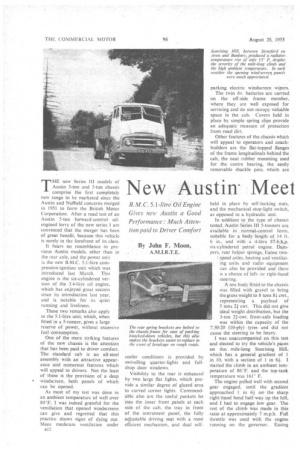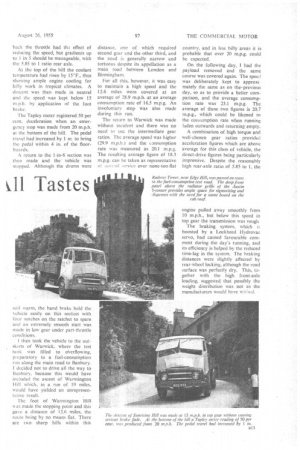New Austin . Meet
Page 46

Page 47

If you've noticed an error in this article please click here to report it so we can fix it.
dl Tastes
B.M.C.5.1-litre Oil Engine Gives new Austin a Good Performance: Much Attention paid to Driver Comfort
By John F. Moon, A.M.I.R.T.E.
THE new Series Ill models of Austin 3-ton and 5-ton chassis comprise the first completely new range to be marketed since the Austin and Nuffield concerns merged in 1951 to form the British Motor Corporation. After a road test of an Austin 5-ton forward-control oilengined lorry of the new series I am convinced that the merger has been of great benefit, because this vehicle is surely in the forefront of its class.
It bears no resemblance to previous Austin models, other than in the rear axle, and the power unit is the new B.M.C. 5.1-litre compression-ignition unit which was introduced last March. This engine is the six-cylindered version of the 3.4-litre oil engine, which has enjoyed great success since its introduction last year, and is notable for its quiet running and liveliness.
These two remarks also apply to the 51-litre unit, which, when fitted in a 5-tonner, gives a large reserve of power, without excessive fuelconsumption.
One of the more striking features of the new chassis is the attention that has been paid to driver comfort. The standard cab is an all-steel assembly with an attractive appearance and numerous features which will appeal to drivers. Not the least of these is the provision of a deep • windscreen, both panels of which can be opened.
As most of my test was done in an ambient temperature of well over 80°F. I was indeed grateful for the ventilation that opened windscreens can give and regretted that this practice shows signs of dying out. More moderate ventilation under cooler conditions is provided by swivelling quarter-lights and fulldrop door windows.
Visibility to the rear is enhanced by two large flat lights, which provide a similar degree of glazed area to curved corner lights. Commendable also are the useful pockets let into the inner front panels at each side of the cab, the tray in front of the instrument panel, the fully adjustable driving seat with a most efficient mechanism, and dual self parking electric windscreen wipers.
The twin 6v, batteries are carried on the off-side frame member, where they are well exposed for servicing and do not occupy valuable space in the cab. Covers held in place by simple spring clips provide an adequate measure of protection from road dirt.
Other features of the chassis which will appeal to operators and coachbuilders are the flat-topped flanges of the frame longitudinals behind the cab, the neat rubber mounting used for the centre bearing, the easily removable shackle pins, which are held in place by self-locking nuts, and the mechanical stop-light switch, as opposed to a hydraulic unit.
In addition to the type of chassis tested, Austin Series HI 5-tonners are available in normal-control form, suitable for a body length of 14 ft. 6 in., and with a 4-litre 87-b.h.p. six-cylindered petrol engine. Dampers, rear helper springs, Eaton two speed axles, heating and ventilating units and radio equipment can also be provided and there is a choice of leftor right-hand steering.
A test body fitted to the chassis was filled with gravel to bring the gross weight to 8 tons 81 cwt., representing a payload of 5 tons 21 cwt. This did not give ideal weight distribution, but the 3-ton .21-cwt. front-axle loading was within the capacity of the 7.50-20 (10-ply) tyres and did not cause the steering to be heavy.
I was unaccompanied on this test and elected to try the vehicle's paces on the mile-long Sunrising Hill, which has a general gradient of I in 10, with a section of 1 in 6f. I started the climb in an ambient temperature of 86°F. and the top-tank temperature was 161° F.
The engine pulled well with second gear engaged, until the gradient approached 1 in 6f on the sharp right-hand bend half-way up the hill, and I had to engage low gear. The rest of the climb was made in this ratio at approximately 7 m.p.h. Full throttle was used with the engine running on the governor. Easing back the throttle had thz effect of reducing the speed, but gradients up to 1 in 5 should be manageable, with the 5.85 to 1 ratio rear axle.
At the top of the hill the coolant temperature had risen by 15°F., thus showing ample engine cooling for hilly work in tropical climates. A descent was then made in neutral and the speed was kept below 15 m.p.h. by application of the foot brake.
The Tapley meter registered 50 per cent, deceleration when art emergency stop was made from 20 m.p.h. at the bottom of the hill. The pedal travel had increased by 1 in. to bring the pedal within 4 in. of the floorboards.
A return to the 1-in-6 section was then made and the• vehicle was stopped. Although the drums were still warm, the hand brake held the vehicle easily on this section with four notches on the ratchet to spare and an extremely smooth start was made in low gear under part-throttle conditions.
I then took the vehicle to the outskirts of Warwick, where the .test tank was filled to overflowing, preparatory to a fuel-consumption run along the main road to I3anbury.
decided not to drive all the way to Banbury, because this would have included the ascent of Warmington Hill which, in a run of 19 miles, would have yielded an unrepresentative result.
The foot of Warnnington Hill w as made the stopping point and this gave a distance of 12.6 miles, the route being by no means flat. There are two sharp hills within this distance, one of which required second gear and the other third, and the road is generally narrow and tortuous despite its appellation as a main road between London and Birmingham.
For all this, however, it was easy to maintain a high speed and the 12.6 miles were covered at an average of 28.9 m.p.h. at an average consumption rate of 16.5 m.p.g. An involuntary stop was also 'made during this run.
The return to Warwick was made without incident and there was no need to use the intermediate gear ratios. The average speed was higher (29.9 m.p.h.) and the consumption rate was measured as 20.1 m.p.g. The resulting average figure .of 18.3 m.p.g. can be taken as representative of clornial ,,ervicc over none-too-flat
country, and in less hilly areas it is probable that over 20 m.p.g. could be expected.
On the following day, I had the payload removed and the same course was covered again. The speed was deliberately kept to approximately the same as on the•previous day, so as to provide a better comparison, and the average consumption rate was 23.1 m.p.g. The average of these two figures is 20.7 m.p.g., which could be likened to the consumption rate when running laden outwards and returning empty.
A combination of high torque and well-chosen gear ratios provided acceleration figures which are above average for this class of vehicle, the direct-drive figures being particularly impressive. Despite the reasonably high rear-axle ratio of 5.85 to 1, the engine pulled away smoothly from 10 m.p.h., but below this speed in top gear the transmission was rough.
The braking system, which is boosted by a Lockheed Hydrovac servo, had caused favourable comment during the day's running, and its efficiency is helped by the reduced time-lag in the system. The braking distances were slightly affected by rear-wheel locking, although the road surface was perfectly dry. This, together with the high front-axle loading, suggested that possibly the weight distribution was not as the manufacturers would have wished.




































































































